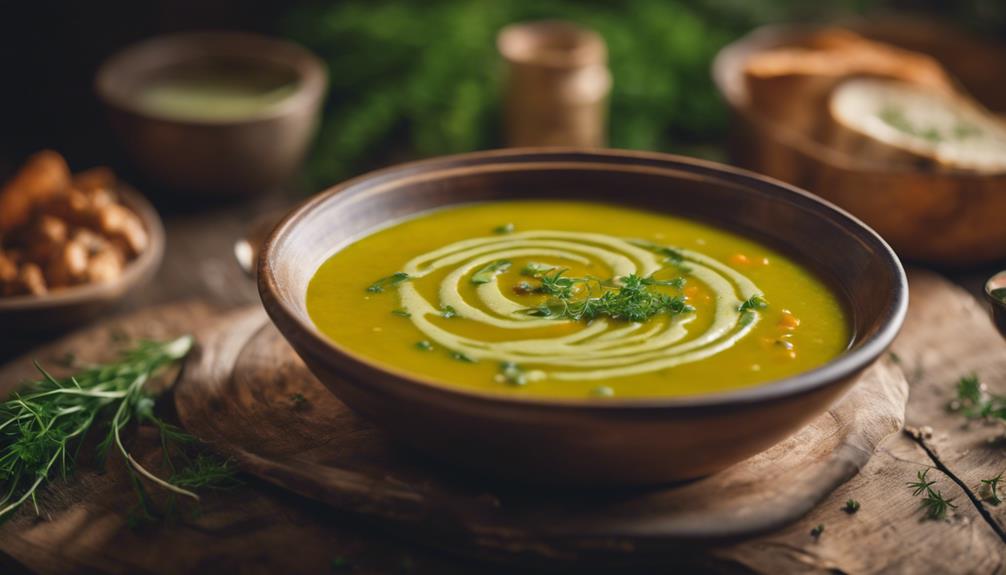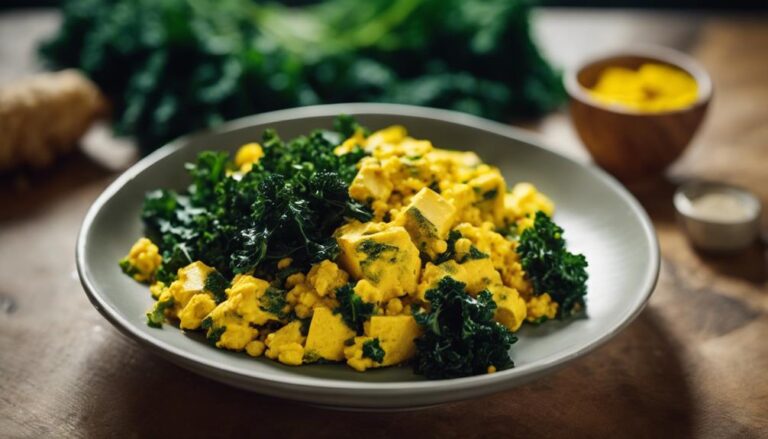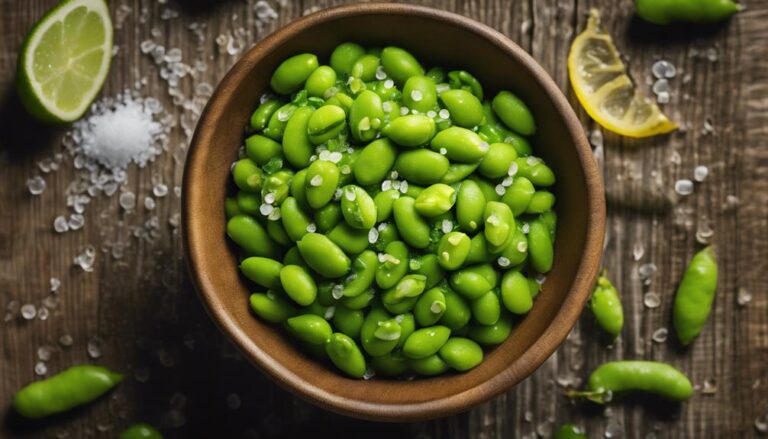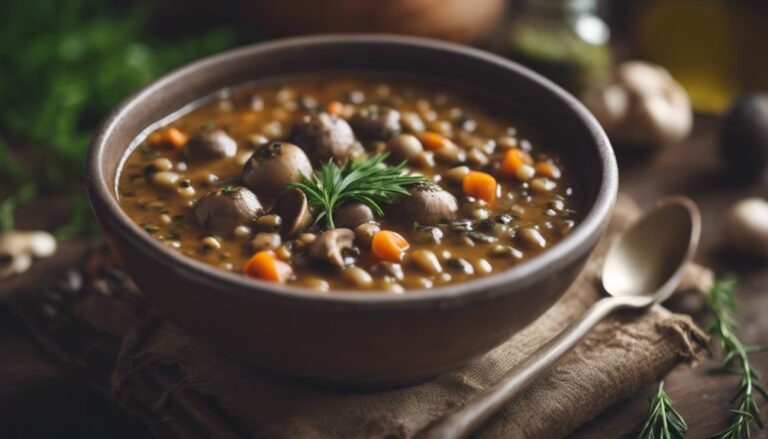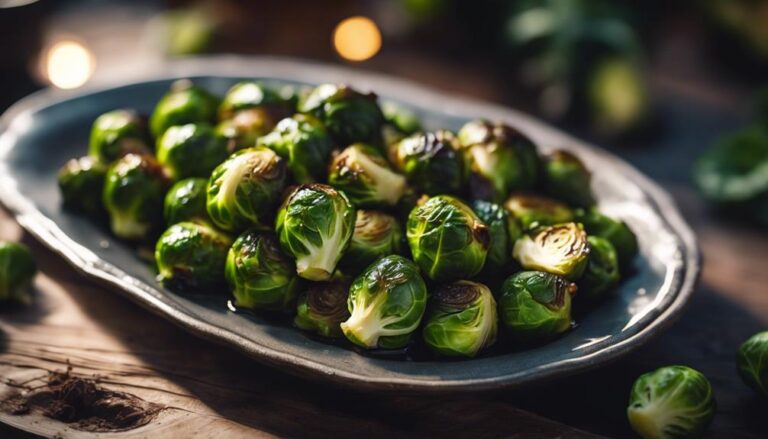Sous Vide Split Pea Soup With Smoky Paprika
Enhance your split pea soup with a sous vide twist, infusing smoky paprika for a depth of flavor. Achieve precise cooking with even heat distribution, resulting in velvety smooth texture and consistent taste. The sous vide method guarantees each spoonful bursts with rich, umami goodness. Elevate your culinary experience with this innovative technique that preserves nutrients and flavors flawlessly. Discover a unique and satisfying dish that showcases modern cooking precision and flavor infusion.
What You Will Learn Here
- Sous vide method ensures precise temperature control for perfectly cooked split peas.
- Smoky paprika enhances flavor profile with a hint of depth.
- Vacuum-sealed bags preserve nutrients and flavors for a rich, umami-packed soup.
- Velvety smooth texture achieved through consistent heat distribution.
- Modern cooking technique elevates traditional split pea soup into a culinary masterpiece.
Origin of Split Pea Soup
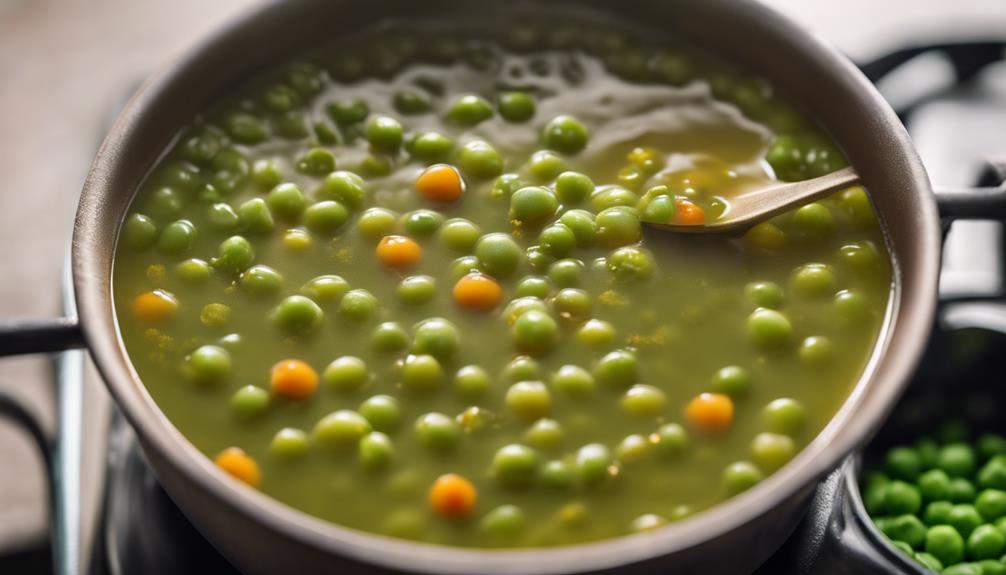
Split pea soup has a diverse history, originating from various regions and cultures. Understanding its historical roots, split pea origins, and traditional soup evolution provides insights into its popularity and variations.
Exploring these aspects can enrich your appreciation for this comforting and versatile dish.
Soup's Historical Roots
Originating from common military fare in Poland and a staple in Sweden and Finland for Thursday meals, Split Pea Soup, known as Snert in Dutch, has a rich historical background. The soup's roots trace back to importance and tradition, showcasing its enduring appeal across various cultures.
In its early forms, ham hock played a significant role in infusing the soup with flavor and depth. Over time, Split Pea Soup evolved into a beloved dish, cherished for its simplicity and nourishing qualities. Its journey from military rations to cultural staple highlights the adaptability and timelessness of this hearty soup.
Understanding its historical significance adds another layer of appreciation to the culinary experience of savoring a warm bowl of Split Pea Soup.
Split Pea Origins
With a heritage deeply intertwined with military cuisine and regional traditions, the evolution of Split Pea Soup into a globally cherished dish reveals a culinary journey influenced by diverse cultural palates.
Split peas, derived from the Pisum sativum plant, have been a staple in various cuisines for centuries. The origins of Split Pea Soup can be traced back to its prominence in the diets of soldiers and common folk due to its hearty nature and long shelf life.
This humble legume, split for easy cooking, has made its way from military provisions to being a beloved comfort food in households worldwide. The adaptability of split peas in different culinary traditions has led to the creation of unique variations of Split Pea Soup across the globe, showcasing its enduring popularity and versatility.
Traditional Soup Evolution
The evolution of traditional soup recipes, like Split Pea Soup, showcases a rich tapestry of culinary heritage and cultural influence.
Yellow split pea soup, a variation favored by Canadians, adds a twist to the classic green pea soup, highlighting the adaptability and regional preferences within the traditional dish.
Historically, Split Pea Soup often included ham hocks, providing a smoky depth of flavor. This incorporation of meat elements reflects the resourcefulness of utilizing various parts of an animal for sustenance, contributing to the evolution of the soup over time.
The use of ham hocks in Split Pea Soup not only enhances the taste but also symbolizes a connection to traditional cooking methods and the preservation of culinary practices across generations.
Pea Soup Color Variations
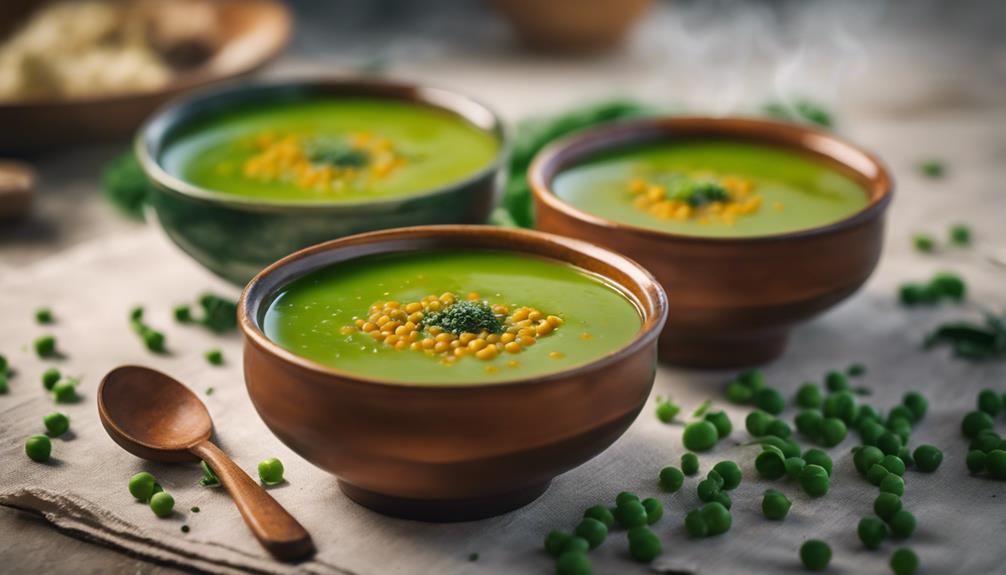
When selecting split peas for your soup, be mindful that the choice of pea color can influence the overall visual appeal of the dish. Here are three key points to keep in mind:
- Visual Impact: Green split peas produce a classic green hue in the soup, while yellow split peas result in a more golden or yellowish appearance. The color contrast can greatly affect the presentation of the dish, appealing to different preferences and cultural backgrounds.
- Canadian Preference: Canadians tend to favor yellow split pea soup over the green version. This cultural preference has influenced the popularity of yellow split pea soups in various regions, highlighting the importance of color in culinary traditions.
- Flavor Perception: Despite the color differences, both green and yellow split pea soups offer a similar taste profile. The color of the split peas doesn't significantly impact the flavor, allowing for flexibility in choosing based on visual aesthetics rather than taste alone.
Top-Rated Split Pea Dishes
When considering the top-rated split pea dishes, options like Sous Vide Pea Soup, Savory Ham Hock Split Pea, and Hearty Dutch Pea Soup Recipe come to mind.
These dishes are renowned for their rich flavors and satisfying textures.
Each recipe offers a unique take on split peas, catering to diverse taste preferences.
Sous Vide Pea Soup
For enhancing the flavors of split pea soup, consider exploring the innovative sous vide method.
- Precise Cooking: Sous vide guarantees that split peas are perfectly cooked while preserving their nutrients and flavors.
- Consistent Results: With sous vide, you can maintain accurate temperature control, leading to a consistently delicious split pea soup.
- Enhanced Depth: The addition of smoky paprika in sous vide split pea soup brings a unique and savory element, elevating the overall flavor profile.
Savory Ham Hock Split Pea
To achieve a top-rated split pea dish, consider incorporating savory ham hock into your recipe for a rich and smoky flavor profile.
- Enhanced Flavor: The ham hock infuses the soup with a deep and meaty essence, elevating the overall taste experience.
- Richness and Depth: The ham hock adds a layer of complexity and richness to the split pea soup, creating a satisfying and hearty meal.
- Subtle Smokiness: By cooking the ham hock with the split peas and spices, you can achieve a subtle smokiness without overpowering the dish.
Hearty Dutch Pea Soup Recipe
Incorporate the traditional Dutch pea soup, known as Erwtensoep, into your culinary repertoire for a rich and hearty dining experience.
When preparing this dish, consider the following:
- Use Smoky Hocks: Enhance the flavor profile of your split pea soup by incorporating smoky hocks or meaty ham bones.
- Opt for Green Split Peas: For an authentic Dutch Erwtensoep, choose green split peas over yellow varieties.
- Slow Cooking Method: Traditional Dutch pea soup is best achieved through slow cooking methods to allow the flavors to meld together perfectly.
Sous Vide Cooking Technique
Sous vide cooking technique offers precise temperature control, ensuring that your ingredients are cooked to perfection.
The method promotes even distribution of heat, resulting in consistently cooked dishes.
Additionally, sous vide enhances flavor retention, keeping your food delicious and full of nutrients.
Precise Temperature Control
With sous vide cooking, achieving precise temperature control down to 0.1 degrees guarantees consistent and accurate results in your culinary creations.
By vacuum-sealing ingredients in a bag and immersing them in a water bath set to a specific temperature, sous vide cooking guarantees even cooking without overcooking.
This method eliminates the risk of undercooked or unevenly cooked food, common in traditional cooking methods.
Unlike a pressure cooker that uses high pressure to cook quickly, sous vide gently cooks food at a controlled temperature, preserving flavors and textures.
The precise temperature control allows you to achieve the exact level of doneness you desire, whether it's a medium-rare steak or a perfectly tender vegetable dish.
Even Cooking Distribution
Maintaining a precise water temperature consistently in Sous Vide cooking is crucial for even distribution of heat, essential for perfectly cooked split pea soup. The Sous Vide technique guarantees that the water temperature remains constant throughout the cooking process, circulating around the vacuum-sealed bag containing the soup.
This controlled environment eliminates hot spots, ensuring uniform cooking. When starting the cooking process, make sure to use cold water to fill the Sous Vide container to prevent temperature fluctuations.
Once the cooking is complete, carefully remove the bag from the water bath, being cautious of any residual heat. This meticulous approach to temperature control and even heat distribution results in a flawlessly cooked split pea soup every time.
Enhanced Flavor Retention
To enhance the flavor retention of your split pea soup using the sous vide cooking technique, focus on infusing and preserving the smoky paprika and other ingredients within the vacuum-sealed bag.
Guarantee that the smoky paprika is evenly distributed by mixing it with freshly ground black pepper before adding it to the bag. This step allows for a more consistent flavor infusion.
During the sous vide process, be mindful to reduce the heat gradually, especially when nearing the end of the cooking time. This controlled reduction prevents any sudden changes that may affect the flavor profile.
Final Thoughts
In conclusion, the sous vide method elevates the traditional split pea soup recipe to a whole new level of precision and flavor infusion. By precisely controlling the temperature, the sous vide technique guarantees that the split peas are cooked evenly and thoroughly, resulting in a velvety smooth texture. The addition of smoky paprika brings a depth of flavor that enhances the natural sweetness of the split peas, creating a unique version of split pea soup that's both comforting and sophisticated.
One of the key advantages of using the sous vide method for split pea soup is the ability to preserve the nutrients and flavors of the ingredients. The vacuum-sealed bag locks in all the essential elements, ensuring that each spoonful is bursting with rich, umami goodness. Additionally, the slow cooking process allows the flavors to meld together harmoniously, resulting in a soup that's cool enough to handle yet hot enough to satisfy your taste buds. Overall, the sous vide split pea soup with smoky paprika is a culinary masterpiece that showcases the innovation and precision of modern cooking techniques.
Frequently Asked Questions
How to Add Flavor to Split Pea Soup?
To enhance split pea soup's flavor, experiment with various seasonings like smoked paprika, chipotle, and cumin. Incorporate ingredients like sweet potatoes, onions, and celery for a sweet-savory balance. Elevate the taste profile with herbs like Herbes de Provence.
How Do You Spice up Bland Pea Soup?
To spice up bland pea soup, get creative with flavorful toppings like crispy bacon and creamy texture with a dollop of sour cream. Elevate it further with homemade croutons and unique garnishes for a satisfying and tasty experience.
How to Spice up Canned Split Pea Soup?
To spice up canned split pea soup, consider adding flavorful additions like smoked paprika, cumin, coriander, and garlic powder. Get creative with seasonings and sautéed onions, carrots, and celery for depth. Top with bacon bits and a dollop of sour cream for extra flavor.
Why Are My Split Pea Soup Peas Not Softening?
If your split pea soup peas aren't softening, consider the quality of the peas and proper soaking. Simmering at a lower temperature may help. High heat can toughen them. Avoid adding salt too soon, as it can hinder softening.
Conclusion
Overall, the sous vide split pea soup with smoky paprika offers a unique twist on a classic dish.
The precision of the sous vide cooking technique guarantees a perfectly cooked and flavorful soup every time.
The addition of smoky paprika adds a depth of flavor that elevates the dish to a whole new level.
This dish is a must-try for any split pea soup lover looking to experience something new and innovative in their culinary repertoire.
